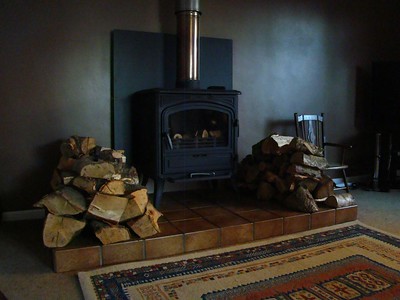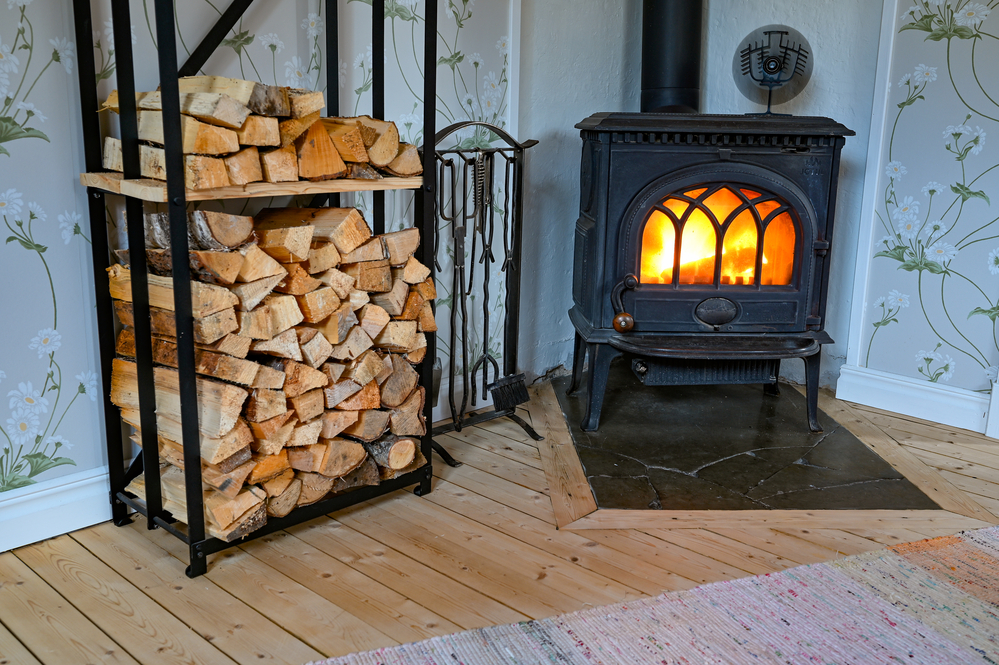Want to level up the warmth in your home? Learn to operate a stove fan to enjoy hot air around the room. Whether you want a cosy atmosphere with minimum temperature or warm air to keep you cosy in winter, there are so many reasons to invest in a stove fan.
So, how does a stove fan work? Stove fans work by conducting heat from the stove’s surface, which then travels up from the aluminium base. The device within the stove fan produces electricity by keeping one side of the stove fan hot and the other much cooler (which is referred to as a ‘thermal difference’) – no batteries are required!
This temperature difference creates a voltage in the circuit, powering the motor, which in turn drives the fan. It’s common for a stove fan to operate from 50°C: a stove thermometer will help you monitor the temperature of your wood-burning stove.
How Do Log Burner Fans Work?
A log burner uses heat from a log burning fire. Simply sit the fan on top of the stove, and once the heat is produced, the heat will start to move the fan blades (a process referred to as thermoelectric power).
With that being said, most fans use an automatic control system, which means that they power on once the temperature reaches a specific amount. Then, once the fan blades are moving, this movement helps to distribute the heat evenly from the log burner, creating a warmer interior from the floor to the ceiling.
How Does a Heat Powered Fan Work?
Stove fans work by using electricity to generate movement, turning into heat. This electricity works by having one side hot and cooler air on the other side: the thermal difference powers the motor, turning on the fan and creating a warmer atmosphere.
Heat-powered stove fans are incredibly convenient tools to use if you own a wood-burning stove or a multi-fuel stove as they circulate warm air in your room, reducing fuel consumption (and less fuel means they are good for the environment too).
Are Two Stove Fans Better Than One?
Having two stove fans instead of just one isn’t necessarily better, and several factors can affect their combined effectiveness. For example, consider the airflow setup, the size of the woodstove and the room setup.
If you notice that there are still cold areas in your home when using two stove fans, you might need to separate them more to expand the heat in the room. If the air immediately close to the woodstove is extremely hot, you might want to adjust the fan to power out air into the colder zone. This is an effective way to warm up a cooler area, and you’ll then see the benefits of using two stove fans to heat the inside of your home.
How a Wood-Burning Stove Works
Wood-burning stoves provide a large amount of heat by burning more wood efficiently and are often eco-friendly. By providing a large amount of heat from firewood, a wood-burning stove adds more warm air to your home in a controlled manner. All the while, burning off excess gases from the fire helps create a hot surface, helping heat evenly distribute around the room.

Moreover, depending on your wood-burning stove’s model, it will likely have one or two air vents. Opening one vent (which is usually positioned on the base of the fan) increases the flow of air to the fire, encouraging the fire to burn through the wood more quickly. As a result, this creates a more significant heat differential, making your home warmer.
Alternatively, closing this air vent minimises the oxygen supplied to the fire, creating a slower wood burn and producing less heat. When it’s time to minimise warm air and switch off the fire, you can completely close the vents to prevent any air from getting to the fire. It’ll then completely go out.
The Benefits of Stove Fans
Not sure if a stove fan is for you? There are so many great reasons to invest in one. One of the biggest benefits you’ll notice is the increase in the warmth that you receive from your stove.
Designed to circulate warm air inside of your house, they direct air from the fireplace into the room rather than just raising the heat from the bottom of the room to the ceiling. As a result, heat doesn’t escape easily.
Effective Flow of Heat
Best of all, you don’t have to wait for stove fans to reach a very high temperature to feel the benefits of the heat. Additionally, having an effective flow of heat around your room can help you to use less money in the long run as you’ll use less heat due to the air circulation.
They Are Aesthetically Pleasing
Most stove fans come in a range of colours and designs, providing you with a variety of design options. Therefore, you can select a stove fan that suits your home’s decor and meets your aesthetic tastes. It’s definitely worth considering your home’s style before having over your money.
Low Noise Level
Use your stove fan at any time during the day or night without worrying that its sound will disturb others. While many fans have some level of noise during operation, stove fans tend to be much quieter, which is great for times/places where noise could be a potential nuisance.
Heat-powered stove fans are much quieter than electric-powered blowers, which come with a loud motor.
Placement and Safety

Finally, it’s time to place and use your stove fan safely. You can position the fan in any direction of the room that suits you. Positioning it so that the heat bounces off the wall and mixes with the cooler air in the room is a great, cost-effective idea.
Then, ensure that the fan is on a flat surface on the top of your stove, and make sure it’s away from the flue pipe. Don’t touch or move the fan once you’ve got the fan going. The base of a stove fan gets extremely hot and can result in injury. If possible, you should also position and keep it away from children and pets.
Keep Your Home Warm
How does a stove fan work? Now that you have the answer, you have a little more understanding of how this seemingly simple device keeps your home warm.
Do stove fans work? The answer is yes. By raising warm air and preventing this air from staying trapped on the ceiling, it’s distributed around the room for a warmer, more comfortable environment.

